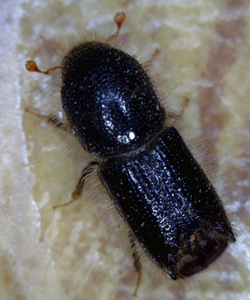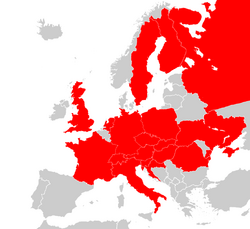Biology:Ips cembrae
| Ips cembrae | |
|---|---|

| |
| Scientific classification | |
| Domain: | Eukaryota |
| Kingdom: | Animalia |
| Phylum: | Arthropoda |
| Class: | Insecta |
| Order: | Coleoptera |
| Infraorder: | Cucujiformia |
| Family: | Curculionidae |
| Genus: | Ips |
| Species: | I. cembrae
|
| Binomial name | |
| Ips cembrae Heer 1836
| |

Ips cembrae, known generally as larch bark beetle or eight-toothed larch bark beetle, is a species of typical bark beetle in the family Curculionidae. Its habitat is Euro-Siberian, ranging from sea level to sub-alpine.[2] It was first recorded in Great Britain in 1955.[3] Populations were said to be found in Japan and China, but further research determined that those were actually Ips subelongatus.[4]
The insect measures around 5 mm and has a dark brown to black colour. The species is considered hard to distinguish visually from Ips typographus.[4]
As a pest
Ips cembrae is native to most of its habitat and is considered less of a pest risk than Ips typographus.[1] The beetle mainly affect the European larix, larix decidua, especially during periods of drought.[3][5] Besides damage from digging tunnels, the beetle also spreads fungi between trees.
Parasites
The species can be infected by several nematode parasites: Contortylenchus, Parasitylenchus, Cryptaphelenchus and Parasitorhabditis endoparasites, Micoletzkya under the wings as phoretic parasites. Laimaphelenchus and Bursaphelenchus are found in the frass.[6]
References
- ↑ 1.0 1.1 EPPO/CABI 1997. Ips typographus. In: Quarantine pests for Europe, 2nd edn. Ed. by Smith IM, McNamara DG, Scott PR, Holderness M, CAB International, Wallingford.
- ↑ Grodski, Wojciech. "Ips cembrae Heer (Col.: Curculionidae, Scolytinae) in young larch stands–a new problem in Poland." Forstschutz Aktuell 44 (2008): 8-9.
- ↑ 3.0 3.1 Crooke, Myles; Bevan, D. (1957). "Note on the First British Occurrence of Ips Cembrae Heer (Col. Scolytidae)". Forestry: An International Journal of Forest Research 30: 21–28. doi:10.1093/oxfordjournals.forestry.a063092.
- ↑ 4.0 4.1 Jeger, Michael; Bragard, Claude; Caffier, David; Candresse, Thierry; Chatzivassiliou, Elisavet; Dehnen‐Schmutz, Katharina; Gilioli, Gianni; Jaques Miret, Josep Anton et al. (2017). "Pest categorisation of Ips cembrae". EFSA Journal 15 (11): e05039. doi:10.2903/j.efsa.2017.5039. PMID 32625339.
- ↑ Hougardy, Evelyne, and J-C. Grégoire. "Biological differences reflect host preference in two parasitoids attacking the bark beetle Ips typographus (Coleoptera: Scolytidae) in Belgium." Bulletin of entomological research 94.4 (2004): 341-347.
- ↑ Grucmanová, Š., Holuša, J., Čermák, V., & Nermuť, J. (2015). Nematodes associated withIps cembrae(Coleoptera: Curculionidae): comparison of generations, sexes and sampling methods. Journal of Applied Entomology, 140(5), 395–403. doi:10.1111/jen.12269
Further reading
- Crooke, Myles, and D. Bevan. "Note on the first British occurrence of Ips cembrae Heer (Col. Scolytidae)." Forestry 30.1 (1957): 21–28.
- "Ips cembrae and Ips subelongatus". EPPO Bulletin 35 (3): 445–449. 2005. doi:10.1111/j.1365-2338.2005.00880.x.
External links
 |

